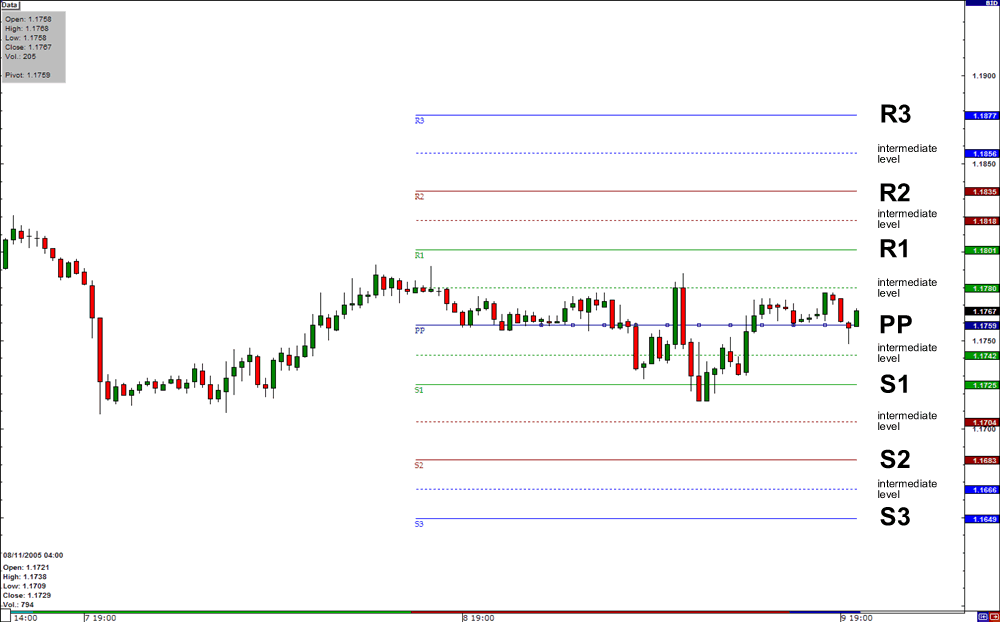Pivot Points
This lesson will cover the following
- What is Pivot Point Technique
- How to calculate Pivot Points
- What is the purpose of Pivot Points
Pivot Point Technique is a method of determining most likely support and resistance levels. It is very commonly used by day traders, so that they are able to form potential price ranges for the day. This technique is also used for confirmation of breakouts.
The pivot point represents the level, where market direction changes during the day. With the help of some simple calculations and the high, low and close prices of previous days, several points can be derived. These points may appear to be crucial support and resistance levels. These several points calculated from that are the so called pivot levels.
During each trading day the market, in which a trader is interested, marks an open, a high, a low and a close prices. This information actually presents all the data needed in order to calculate the pivot points.
The main reason pivot point trading has gained so much popularity is that pivot points have a predictive nature and are also easily calculated. Traders use the information regarding the prior day in order to calculate potential turning points for the current day, the day he/she intends to trade.
How to calculate pivot points
As a large number of traders stick to pivot points, it is evident that the market reacts at these pivot levels. This usually provides a great opportunity to enter into trades. If a trader prefers to work the pivot points out by himself/herself, the formula used is as follows:
Pivot Point = ( High + Close + Low )/3
Resistance 3 = High + 2*(Pivot – Low)
Resistance 2 = Pivot + (R1 – S1)
Resistance 1 = 2 * Pivot – Low
Support 1 = 2 * Pivot – High
Support 2 = Pivot – (R1 – S1)
Support 3 = Low – 2*(High – Pivot)
Explanation
As can be seen from the formula above, by taking the high, low and close prices of previous days a trader eventually ends up having 7 points at his/her disposal: 3 resistance levels, 3 support levels and the actual pivot point.
In case the market opens above the pivot point, then the current days bias is more likely for long positions, as long as the price remains above the pivot point. In case the market opens below the pivot point, then the current days bias is more likely for short positions, as long as the price remains below the pivot point.
The idea behind trading pivot points is to expect a reversal or break of R1 or S1. By the time price action reaches R2 and R3 or S2 and S3, the instrument will already be overbought or oversold, while these levels should better be used for exiting the market rather than entering.
A perfect scenario would be if the market opens above the actual pivot point, then stall slightly at R1 and continue to R2. A trader would prefer to enter on a break of R1 with setting R2 as a target and, if the market demonstrates strength, close half of his/her position at R2. Then, the next target will be R3 with the remaining part of the position.
The major advantage of this pivot point technique lies in the fact that many traders are using the same levels based on the same formula. There is no discretion involved. In contrast, the method of drawing support and resistance levels and trend lines can be more subjective.
What is specific about pivot lines is, that they may turn out to be a battleground for past and future price action. After a trader inserts the appropriate pivot lines on his/her chart, all the “historic battle sites” of the market can be seen. More specifically, those pivot levels bounced and broken, those support and resistance levels held and overtaken. Thus, it becomes possible for a trader to predict where “future battles” in the market will probably take place.
We can say that pivot lines grant any trader access into the “Generals tent”, where “the armies of the bulls and the bears” are positioned on the map. Once a trader obtains this knowledge, he/she is able to construct his/her own strategy.
